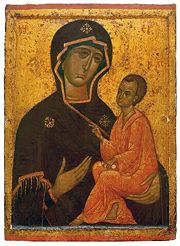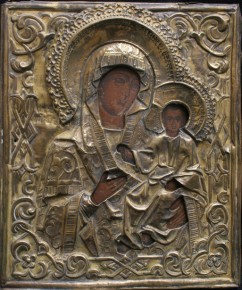Hodigitria and the Mother of God of Tikhvin
Fifth century Byzantine Empress Eudocia brought this icon painted by St. Luke to Constantinople where it eventually was carried in procession every Tuesday.
The icon's name Hodigitria (also spelled Hodegetria) means She who shows the way.
The title is traced to the miraculous restoration of sight to two blind men.
Hodigitria saved the city from the attacks of the Persians in 625 and the Moslems in 655 and 705.
The citizens of the city saved the icon from the Latin pillagers in 1204 but the Venetians captured it and held it until the city was liberated by Emperor Michael VIII Palaeologus in 1261.
During the Fall of Constantinople to the Turks on May 29, 1453, the icon was in the Chora Church in view of the defenders. The Turks cut the icon into
four parts and destroyed it.

Another icon of St. Luke, the Mother of God of Tikhvin (pictured), was known for its unique method of transport. Housed in the Blachernae Church in Constantinople, it disappeared in 1383 and appeared hovering above the water in Lake Ladoga in Russia.
After being recovered by fishermen, it miraculously moved several more times, finally resting in Tikhvin where a church and monastery were built to honor it near Novgorod. The icon helped outnumbered defenders repulse the Protestant Swede invaders
in 1613-1614: the Swedes could not get in and the defenders could not leave.
The Mother of God of Smolensk is a third icon of St. Luke that is similar in style to other Hodigitria icons.



|